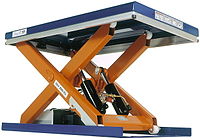Scissors mechanism


A scissors mechanism uses linked, folding supports in a criss-cross 'X' pattern.[1]
The scissor mechanism is a mechanical linkage system used to create vertical motion or extension. It consists of a series of interconnected, folding supports that resemble the shape of a pair of scissors, hence its name. The scissor mechanism is widely employed in various applications, including scissor lifts, folding tables, adjustable height platforms, and automotive jacks.[2]
Workings
[edit]Extension is achieved by applying pressure to the outside of a set of supports located at one end of the mechanism, elongating the crossing pattern. This can be achieved through hydraulic, pneumatic, mechanical or simply muscular means.
A power source is turned on resulting in the flow of hydraulic fluid or air (in the case of a pneumatic lift) in the cylinder. The hydraulic cylinder thrust outward for upraised movement and that in turn lead the scissor legs to spread and raise the platform table upwards. To lower the lift, the operator uses a down valve to release hydraulic fluid or pneumatic pressure, which causes the scissor legs to retract.[3][4]
Uses
[edit]This mechanism is used in devices such as lift tables and scissor lifts. Modern low-profile computer keyboards make an extensive use of it as well, installing each key on a scissor support to ensure their smooth vertical movement, allowing the use of a cheap and reliable rubber dome contact set, instead of expensive and complex array of mechanical switches.
See also
[edit]References
[edit]- ^ "Scissor Lift Jack Review & Equations". Engineers Edge, LLC. Retrieved January 2, 2012.
- ^ "Mechanical engineering concepts: Pantograph or scissor mechanisms". lo.unisa.edu.au. Retrieved 2023-05-16.
- ^ "Scissor Lift". Aakash Engineers. Retrieved 2023-05-16.
- ^ "Mechanical engineering concepts: Pantograph or scissor mechanisms". lo.unisa.edu.au. Retrieved 2023-05-16.
Text is available under the CC BY-SA 4.0 license; additional terms may apply.
Images, videos and audio are available under their respective licenses.
